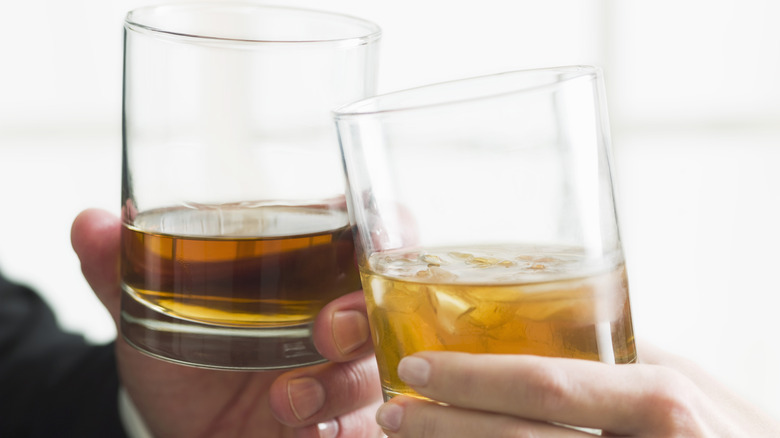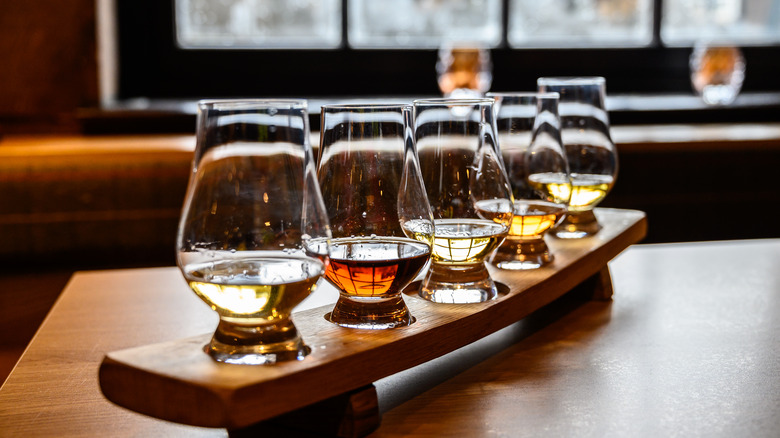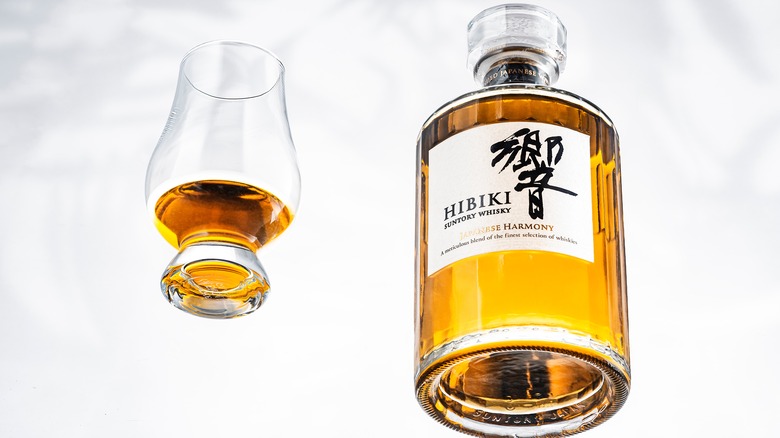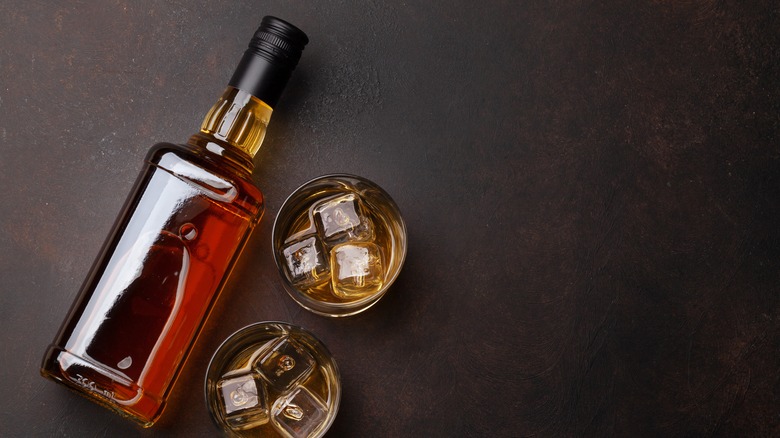Look Closer — Whiskey And Whisky Are Not The Same Thing
What do Scotch and bourbon have in common? Their names might not give it away, but they're both whisky ... or should we say whiskey? Is it with an 'e' or not? It can be confusing to parse out the difference between whiskey and whisky, never mind the differences between various types of each. But it turns out there's one easy way to understand the difference between whiskey with an 'e' and whisky without it once and for all.
For starters, they are the same drink. Both are distilled spirits that are made with fermented grains and aged in wood. But while you'll find this spirit labeled whiskey in the United States and Ireland, in other countries, like Scotland, Japan, Australia, and India, it's called whisky. There are a couple of exceptions to this rule — Maker's Mark and George Dickel are two Tennessee distilleries that call their products whisky — but in general, that's the rule. American or Irish? Whiskey. Made elsewhere? Whisky.
But that really just tells you about where the spirit comes from, not what it will taste like. Though these are all distilled spirits made of fermented grain or malt and then aged in wood, there are many different styles and flavor profiles to be found in whiskey and whisky.
What is whisky?
Scotch whisky is arguably the most famous kind of whisky, and is often just called Scotch. The name refers to Scottish whiskies made from malt or grain, and the art of making Scotch whisky can be traced to the 15th century. Single-malt Scotch whiskey is a fine spirit made at a single distillery from just water, malted barley, and yeast. Single-grain Scotch whisky can be made with malted barley and other grains, and blended Scotch whisky, which tends to be the cheapest, is a mix of different whiskies and can include flavorings, colorings, and neutral spirits as well. Some varieties of Scotch are known for being smoky or peaty (like Islay), and some are known for having vanilla or fruity notes (like Speyside), all depending on the methods and ingredients used by the distillers.
Single malt Scotch whisky is often considered to be the best and is usually the most expensive. It's aged longer than blended whisky, and is typically made with barley grown in one region. That means single malt Scotch whisky will have special characteristics that are unique to the area where the grain was sourced and distilled (similar to the concept of terroir in the wine industry). Another factor is that many of these prized whiskys are made by small distilleries, meaning they have limited availability. All of these factors lead to single malt Scotch's reputation as being the best of the best — and to its high price tag.
Canadian and Japanese whisky
In Canada, blended whisky made from a base grain spirit that's mixed with a flavoring spirit made from rye or corn is most popular, and 100% rye whisky, prized for its "spicy" kick, is common, too. Single-malt Canadian whisky is usually only seen at craft distilleries. There's a lot of flexibility for Canadian whisky-makers; the only requirements to be labeled "Canadian whisky" are that it is distilled in Canada and it has been aged in oak for at least three years. Also of note is that Canadian whisky is often re-labeled in the United States by American brands, like Whistle Pig, demonstrating that Canadian whisky often has much in common with American whiskey, despite the vowel difference.
Japanese whisky's popularity has grown exponentially over the past 20 years. Unlike in Scotland, where single malt whisky is the most prized, Japanese distillers are famed for their ability to create interesting, complex, and harmonious blended whisky using single-malt and single-grain spirits to start with. Japanese whisky can be aged in different types of wooden barrels, and the climate where the whiskies are being aged can affect the flavors as well. In general, most whisky aged in Japan will see more hot and humid temperatures than in Scotland, paired with cold winters, leading to some unique flavors. Japanese whisky tends to be expensive compared to other whiskies and whiskeys, mostly because of limited supply and high demand. Fakes abound, too, so shoppers should look for bottles distributed by reputable companies like Nikka and Suntory.
What is whiskey?
Irish whiskey is the original whiskey. It's believed to have been invented in the Middle Ages, and Bushmill was the first whiskey distillery in the British Isles, opening in 1608. Irish whiskey tends to have a milder flavor profile than Scotch whisky and American whiskey, and is triple distilled, which increases the alcohol content but helps to mellow out any harsh flavors.
Then, there are different varieties of American whiskey. Jack Daniels is the most popular example of Tennesee whiskey, which is legally required to be made from 51% or more of corn, aged in new charred oak barrels, and charcoal-filtered before being barreled, a step known as the Lincoln County process. Bourbon is another American whiskey. It's also made up of mostly corn and aged in new charred oak barrels. In order to be called bourbon, the whiskey must be made in the United States though it can be made outside Bourbon County, Kentucky, which is where the name originates. It tends to have caramel, spice, and oak notes.
Whiskey and whisky might sound alike, yet there's a huge variety within the category. But whether you're sipping Scotch whisky, Irish whiskey, or American bourbon, chances are you're about to have a good time.



